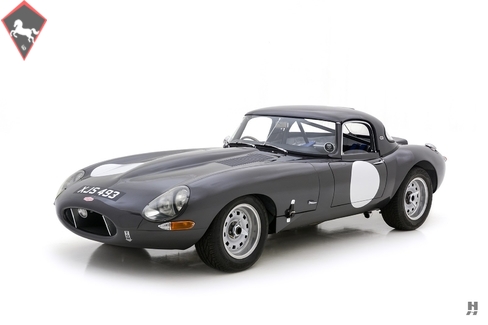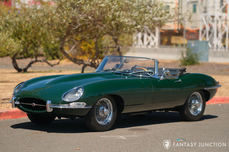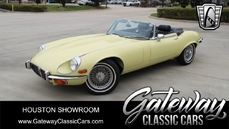Jaguar E-type Semi-Lightweight Roadster 1962
Allmän beskrivning :
Throughout the 1950s, Jaguar worked feverishly to establish its dominance in sports car and endurance racing. The XK120 was a popular choice for club racers, although the factory required something more focused for use in world-championship events. The legendary C-Type (officially the XK120-C) used modified XK120 running gear in a lightweight tubular frame and skinned in a beautiful alloy body. The light and powerful C-Type won the 24h of Le Mans on its first attempt in 1951, sparking a string of victories at the French classic that continued throughout the 1950s. Dunlop disc brakes arrived in 1953, marking one of the most significant developments in motorsport, and are widely credited for Jaguar’s second Le Mans win that year. In 1954, the revolutionary D-Type replaced the C-Type as the top works racing car. Designers scrapped the tubular chassis in favor of a light and sturdy semi-monocoque tub and then wrapped the car in stunning bodywork courtesy of Jaguar’s aerodynamics-obsessed stylist Malcolm Sayer. Despite a horsepower disadvantage, the slippery shape allowed it to be more than 12 mph faster down the Mulsanne straight than the brutally powerful 4.9-liter Ferraris, and Jaguar scored three more victories at Le Mans in 1955, 1956 and 1957.
While the E-Type road car shared much of its DNA with the purebred D-Type, Jaguar never seemed as committed to developing it into a top-tier racer. The first attempt was a fixed-roof GT known by its famous registration number “CUT 7.” That car wore gorgeous low-drag bodywork designed by Sayer, with an evolution of the D-Type engine. But instead of developing the low-drag concept, Jaguar abruptly changed course in favor of a lightweight, all-alloy version of the E-Type OTS roadster. The styling was essentially the same as the road cars, but subtly widened to accommodate the fat Dunlop alloy wheels, but the real difference lay in the use of aluminum for the tub, bodywork, and 3.8-liter block. By the time the lightweight E-Type debuted in 1963, a new prototype class had opened up the World Sportscar Championship to more exotic, purpose-built machinery, effectively killing Jaguar’s chance of continuing their streak of overall victories at Le Mans and Sebring. Jaguar sold just twelve of a planned sixteen cars, and while works cars saw limited results, privateers like Briggs Cunningham, Peter Sutcliffe, and Peter Lindner proved the Lightweight E-Type could be a winner, even against Ferrari’s formidable 250 GTO. Today, the works lightweights are some of the most valuable cars in the world, making even Jaguar’s factory-built continuation cars seem like a relative bargain at over $1M apiece. But many enthusiasts keep the legend alive through recreations built from standard E-Type road cars, and these so-called “semi-lightweight” E-Types are quite popular in historic motorsport events around the world.
This Jaguar E-Type 3.8 is an evocative and beautifully prepared “semi-lightweight” built to a very high standard from a 1962 OTS donor car. Mr. Mark Wright of Leicester, England, commissioned Brian Wilkinson’s Zealia Engineering to create this car for use in the highly-competitive club racing scene in the UK. The late Mr. Wilkinson was highly respected in motorsport circles, noted as the founder of the roll cage and harness manufacturer Safety Devices Motorsport. Later in his career, he founded Zealia Engineering, which specialized in building lightweight E-Types such as this.
In the transformation from standard to “semi-lightweight,” Zealia Engineering scrapped much of the original sheet metal, leaving only the steel tub and subframes. To that, they fitted high-quality fiberglass panel including a one-piece bonnet, lightweight doors, hardtop, boot lid, and a flared tail section made to accommodate fatter rear rubber. The car now wears a beautiful opalescent gray livery with white roundels, similar to the early works cars. Paint quality is excellent, and the fit of the bodywork is quite good, particularly for a purpose-built club racing car. The ventilated lightweight boot lid and hardtop stay true to the original form, and details such as outside bonnet locks with leather straps, an oversize Monza-style fuel filler, flush headlamp covers, and magnesium Dunlop pin-drive wheels complete the look.
The two-place cockpit features period-correct bucket seats trimmed in dark blue leather and is otherwise stripped out for the singular purpose of racing. Zealia Engineering built the FIA-approved roll bar and added a “works” style transmission tunnel – which allows mechanics to change the gearbox without first removing the engine. Instrumentation consists of Vicarage tach and speedo, with updated minor gauges and switchgear in the standard locations. The co-driver’s side features a Halda Speedpilot trip computer and a chronograph, great for competitive historic rallying.
At the heart of this E-Type is a 3.8-liter, dry-sump XK with 9:1 pistons, wide blade rods, and large stainless steel valves. Three Weber DCOE carbs attach to a high flow manifold, and cooling is suitably updated with a Series 2 water pump, large alloy radiator, Kenlowe fan, and the 3-gallon Zealia belt-driven dry-sump oiling system. The engine feeds a 5-speed Getrag gearbox, going back to a 3.31 limited-slip rear diff with lightened half-shafts. The suspension consists of adjustable Spax dampers, uprated springs and torsion bars, and lightweight rear wishbones. Braking is by AP 4-piston calipers with huge ventilated discs in front and uprated Girling calipers from an XJ in the rear.
Previous caretaker Mark Wright competed in numerous Jaguar Owner’s Club and Aston Martin Owner’s Club track events in the UK, with highlights including an impressive pole-lap of 0:57.68 at Brands Hatch, and beating the famous CUT 7 in a JOC event at Silverstone. An impressive stack of time sheets accompanies the history file, which also includes build records, correspondence, and a copy of a FIVA Passport in a previous owner's name. Equipped for street, rally, or race duty, it remains in superb running order and is properly quick while also proving quite tractable and driver-friendly, even for the occasional blast along your favorite back roads. This is a fantastic opportunity to acquire a proven and beautifully prepared “semi-lightweight” E-Type for historic rallying, circuit racing, or thrilling fast-road enjoyment.
Offers welcome and trades considered
https://hymanltd.com/vehicles/6633
1962 Jaguar E-type Semi-Lightweight Roadster is listed såld on ClassicDigest in St. Louis by Mark Hyman for $149500.
Fakta i bilen
Karosstyp : Personbil Märke : Jaguar Modell : E-type Modellversion : Semi-Lightweight Roadster Motorvolym : 0.0 Årsmodell : 1962 Karosstyp : Convertible Läge : Missouri
Såld
Information om säljaren
Såld
People who viewed this Jaguar E-type also viewed similar Jaguar listed at ClassicDigest
Other cars listed for sale by this dealer
om Jaguar
Åh, historien om Jaguar, från dess tidiga dagar som SS Cars Ltd. till sin höjdpunkt med D-typen och gatubilsevolutionen i form av den ikoniska E-typen. Det finns något alldeles brittiskt över denna berättelse, och jag ska berätta den som en brittisk journalist skulle göra.
I början:
Vår resa in i Jaguar-världen börjar på 1930-talet, när ett företag som kallades SS Cars Ltd. dök upp. Trots den olyckliga sammanträffandet av deras initialer med de stigande politiska spänningarna i Europa började de producera stilfulla och prestandainriktade bilar. SS 100, som introducerades 1936, var en symbol för elegans och hastighet och lade grunden för vad som skulle bli Jaguar.
Jaguars födelse:
När skuggan av andra världskriget närmade sig beslutade SS Cars Ltd. klokt att distansera sig från SS-initialerna. Så 1945 blev de officiellt Jaguar Cars Ltd., ett namn som snart skulle bli synonymt med brittisk lyx och prestanda.
XK-serien:
Jaguars efterkrigstid gav oss XK 120, en verklig sensation 1948. Med sin strömlinjeformade design och en kraftfull 3,4-liters raksexmoters blev den världens snabbaste seriebil. XK 120 var ritningen för det som komma skulle - Jaguar som förenade stil med hastighet på ett unikt brittiskt sätt.
D-typens dominans:
Sedan kom D-typen, en sann racinglegend. Introducerad 1954, vann den Le Mans tre gånger på 1950-talet och visade Jaguars tekniska skicklighet. Med sin innovativa monokokkonstruktion och den ikoniska fenan bak var D-typen höjdpunkten av Jaguars framgång inom motorsport.
E-typens framträdande:
Men den verkliga vändpunkten kom 1961 med introduktionen av E-typen, ofta beskriven av Enzo Ferrari som "den vackraste bilen som någonsin byggts". Dess långa motorhuv, böljande kaross och en 3,8-liters motor som levererade upphetsande prestanda gjorde den till en omedelbar klassiker. E-typen var inte bara en bil; den var ett konstverk på hjul och kunde nå 150 mph på vägen.
Gata och racingsuccé:
E-typens skönhet matchades av dess förmåga på racerbanan. De lätta E-typarna var särskilt framgångsrika i olika racingevenemang och cementerade Jaguars rykte som en kraft att räkna med inom motorsport.
Raffinemangets ålder:
När vi fördjupar oss i Jaguar-historien finner vi att 1950-talet och 1960-talet var en tid av raffinering och expansion. Tillsammans med den magnifika D-typen och den ikoniska E-typens framträdande introducerade Jaguar modeller som ytterligare befäste sitt rykte för lyx och prestanda.
MK2:
I slutet av 1950-talet presenterade Jaguar MK2, en sportig sedan som kombinerade elegans med kraft. Denna eleganta fyradörrars salong var en favorit bland bankrånare och polisen, tack vare dess exceptionella hastighet och hantering. MK2 var en symbol för Jaguars förmåga att förena sofistikering med prestanda och hade också en framgångsrik racingkarriär.
XJ6:
Hoppa fram till 1968 och Jaguar lanserade en bil som skulle definiera lyxbilar i decennier framöver - XJ6. Det var ett mästerverk i teknik och design med en jämn raksexmoters, oberoende bakre fjädring och en rymlig, vackert inredd interiör. XJ6 var en symbol för brittisk elegans och erbjöd en så smidig åktur att det kändes som om den gled över vägen. Den blev flaggskeppsmodellen för Jaguar och satte standarden för lyxbilar och visade en nivå av raffinering som imponerade på konkurrenterna.
Blandningen av klassiskt och modernt:
Medan MK2 och XJ6 representerade utvecklingen av Jaguars sedanmodeller, bibehöll de märkets engagemang för prestanda och lyx. Dessa bilar hörde inte bara hemma på racerbanan; de trivdes lika bra på de stora boulevarderna som på en avslappnad körning genom den engelska landsbygden.
Utmaningarna av förändring:
Men när 1970-talet närmade sig, ställdes Jaguar, liksom många brittiska biltillverkare, inför ekonomiska utmaningar och ägarförändringar. British Leyland-eran förde både möjligheter och svårigheter med sig när varumärket navigerade genom olika sammanslagningar och övergångar.
Ändå fortsätter arvet från MK2 och XJ6, tillsammans med D-typen och E-typen, att definiera Jaguar som en tillverkare som förenar tidlös elegans med en anda av prestanda. Dessa klassiska modeller, vare sig de körs på slingrande vägar eller står som samlarföremål, tjänar som ett vittnesbörd om Jaguars långvariga närvaro inom den automobila exklens värld.
Jaguar-historien, från dess tidiga dagar som SS Cars Ltd. till skapandet av ikoner som E-typen, MK2 och XJ6, är en resa som speglar essensen av brittisk bilkultur - en blandning av lyx, kraft och stil som fortsätter att fängsla entusiaster och samlare över hela världen.











